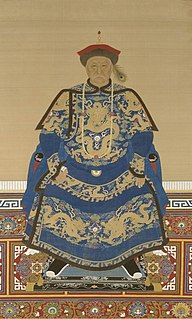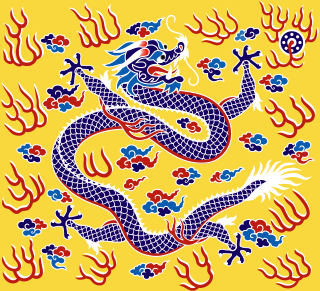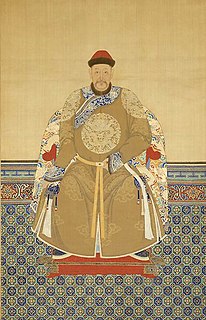
Dorgon, ; 17 November 1612 – 31 December 1650), formally known as Prince Rui, was a Manchu prince and regent of the early Qing dynasty. Born in the Aisin Gioro clan as the 14th son of Nurhaci, Dorgon started his career in military campaigns against the Ming dynasty, Mongols and Koreans during the reign of his eighth brother, Hong Taiji, who succeeded their father. After Hong Taiji's death in 1643, he was involved in a power struggle against Hong Taiji's eldest son, Hooge, over the succession to the throne. Both of them eventually came to a compromise by backing out and letting Hong Taiji's ninth son, Fulin, become the emperor; Fulin was installed on the throne as the Shunzhi Emperor. Dorgon served as Prince-Regent from 1643–1650, throughout the Shunzhi Emperor's early reign. In 1645, he was given the honorary title "Emperor's Uncle and Prince-Regent"; the title was changed to "Emperor's Father and Prince-Regent" in 1649. Under Dorgon's regency, Qing forces occupied Beijing, the capital of the fallen Ming dynasty, and gradually conquered the rest of China in a series of battles against Ming loyalists and other opposing forces around China. Dorgon also introduced the policy of forcing all Han Chinese men to shave the front of the heads and wear their hair in queues just like the Manchus. He died in 1650 during a hunting trip and was posthumously honoured as an emperor even though he was never an emperor during his lifetime. A year after Dorgon's death, however, the Shunzhi Emperor accused Dorgon of several crimes, stripped him of his titles, and ordered his remains to be exhumed and flogged in public. Dorgon was posthumously rehabilitated and restored of his honorary titles by the Qianlong Emperor in 1778.

Hong Taiji, sometimes written as Huang Taiji and formerly referred to as Abahai in Western literature, was an Emperor of the Qing dynasty. He was responsible for consolidating the empire that his father Nurhaci had founded and laid the groundwork for the conquest of the Ming dynasty, although he died before this was accomplished. He was also responsible for changing the name of his people from Jurchen to Manchu in 1635, as well as that of the dynasty from Later Jin to Qing in 1636. The Qing dynasty lasted until 1912.

Oboi was a prominent Manchu military commander and courtier who served in various military and administrative posts under three successive emperors of the early Qing dynasty. Born to the Guwalgiya clan, Oboi was one of four regents nominated by the Shunzhi Emperor to oversee the government during the minority of the Kangxi Emperor. Eventually deposed and imprisoned by the new emperor for having amassed too much power, he was posthumously rehabilitated.

Dodo, formally known as Prince Yu, was a Manchu prince and military general of the early Qing dynasty.

Aisin Gioro was the imperial clan of Manchu emperors of the Qing dynasty. The House of Aisin Gioro ruled China from 1644 until the Xinhai Revolution of 1911-12, which established a republican government in its place. The word aisin means gold in the Manchu language, and "gioro" is the name of the Aisin Gioro's ancestral home in present-day Yilan, Heilongjiang Province. In Manchu custom, families are identified first by their hala (哈拉), i.e. their family or clan name, and then by mukūn (穆昆), the more detailed classification, typically referring to individual families. In the case of Aisin Gioro, Aisin is the mukūn, and Gioro is the hala. Other members of the Gioro clan include Irgen Gioro (伊爾根覺羅), Šušu Gioro (舒舒覺羅) and Sirin Gioro (西林覺羅).
Hešeri, is a Manchu clan with Jianzhou Jurchens roots, originally hailing from the area which is now the modern Chinese provinces of Jilin and Liaoning. It was once one of the most important and powerful families in the early Qing dynasty in China, second only to the royal House of Aisin Gioro, to whom they were closely related by marriage. The power of the family reached its zenith in the period of Marquess Hešeri Sonin and his second son Duke Hešeri Songgotu. Although its influence declined following Songgotu's death, clan Hešeri continued to play a role in Chinese politics until the demise of the Qing dynasty in early 1912.
Ebilun was a Manchu noble and warrior of the Niohuru clan, most famous for being one of the Four Regents assisting the young Kangxi Emperor from 1661 to 1667, during the early Qing dynasty (1644–1912). A largely passive figure during the regency, Ebilun was disgraced following the ouster of the far more powerful regent Oboi and considered a political supporter of the latter. He was stripped of his positions by the emperor but later regained his noble rank. Many of his descendants became influential figures in the Qing imperial government.

The Plain Yellow Banner was one of the Eight Banners of the Manchu Qing dynasty military. The Plain Yellow Banner was one of three "upper" banner armies under the direct command of the emperor himself, and one of the four "right wing" banners. The Plain Yellow Banner was the original banner commanded personally by Nurhaci. The Plain Yellow Banner and the Bordered Yellow Banner were split from each other in 1615, when the troops of the original four banner armies were divided into eight by adding a bordered variant to each banner's design. After Nurhaci's death, his son Hong Taiji became khan, and took control of both yellow banners. Later, the Shunzhi Emperor took over the Plain White Banner after the death of his regent, Dorgon, to whom it previously belonged. From that point forward, the emperor directly controlled three "upper" banners, as opposed to the other five "lower" banners.

The Bordered Blue Banner was one of the Eight Banners of the Manchu Qing dynasty military. It was one of the lower five banners. According to the general annals of the Eight Banners, Bordered Blue Banner was one of the banners that was located on the south right wing.

Nara is a clan name shared by a number of royal Manchu clans. The four tribes of the Hūlun confederation (扈倫四部) – Hada, Ula, Hoifa and Yehe – were all ruled by clans bearing this name.

Daišan was an influential Manchu prince and statesman of the Qing dynasty.
Fuzhen (符珍), also known as Ruiyu, born of the Manchu Guwalgiya clan, was a noble of the Qing Dynasty. He was a member of the Bordered Yellow Banner of the Qing Dynasty's Eight Banners, and a direct descendant of Fiongdon (費英東), who served under the Qing Dynasty's founder Nurhaci. Fuzhen held the hereditary title of First Class Duke Xiongyong (一等雄勇公). In 1873 he married the Xianfeng Emperor's daughter Gurun Princess Rong'an and was granted the title of Prince Consort (額駙).
Jirgalang or Jirhalang was a Manchu noble, regent, and political and military leader of the early Qing dynasty. Born in the Aisin Gioro clan, he was the sixth son of Šurhaci, a younger brother of Nurhaci, the founder of the Qing dynasty. From 1638 to 1643, he took part in many military campaigns that helped bring down the fall of the Ming dynasty. After the death of Huangtaiji in September 1643, Jirgalang became one of the young Shunzhi Emperor's two co-regents, but he soon yielded most political power to co-regent Dorgon in October 1644. Dorgon eventually purged him of his regent title in 1647. After Dorgon died in 1650, Jirgalang led an effort to clean the government of Dorgon's supporters. Jirgalang was one of ten "princes of the first rank" (和碩親王) whose descendants were made "iron-cap" princes (鐵帽子王), who had the right to transmit their princely titles to their direct male descendants perpetually.

Nurhaci was a Jurchen chieftain who rose to prominence in the late 16th century in Manchuria. Nurhaci was part of the Aisin Gioro clan, and reigned from 1616 to his death in September 1626.
Šurhaci, was a Jurchen leader, a member of the Aisin Gioro clan, he was a younger brother of Nurhaci, the founder of the Later Jin dynasty, of what would become the Qing dynasty. Under the Ming dynasty government, he held the title of local chieftain (都指揮) in the Jianzhou district, and maintained relations with the Ming authorities up to the beginning of 1607. In that year, he joined Nurhaci in the campaign against Bujantai and the Ula tribe, receiving the title of darhan baturu. However, as a result of disargreements with his brother over the conquest of the Hoifa and the killing of Hoifa's beile Baindari in 1607, he was put to death four years later at Nurhaci's order and buried in Dongjingling Township, Liaoyang. In 1653, he was posthumously given the rank of qinwang under the posthumous title Prince Zhuang of the First Rank.

Later Jin was a khanate established by the Jurchen khan, Nurhaci in Manchuria during 1616–1636, and was the predecessor of the Qing dynasty. In 1616, Nurhaci declared himself to be the khan of the Jurchen nation and adopted the name of the former Jurchen Jin dynasty (1115–1234) for this newly established state, which is now usually called "Later Jin" by Chinese historians. The son of Nurhaci, Hong Taiji, after he conquered the last Khagan Ligdan Khan in Inner Mongolia, renamed this khanate as "Great Qing", which later became a Chinese dynasty for nearly three centuries after its conquest of China proper. The Later Jin existed for 21 years and was ruled by two khans.

Manggūltai was a Manchu noble and an important military and political leader in the early years of the Qing dynasty. He helped Hong Taiji consolidate his power by handing over his Plain Blue Banner to Taiji's. He died when he was 45 to 46 years old in 1633.
Fiongdon ; 1564 – 1620), was a Manchu official and one of the earliest companions of Nurhaci.












